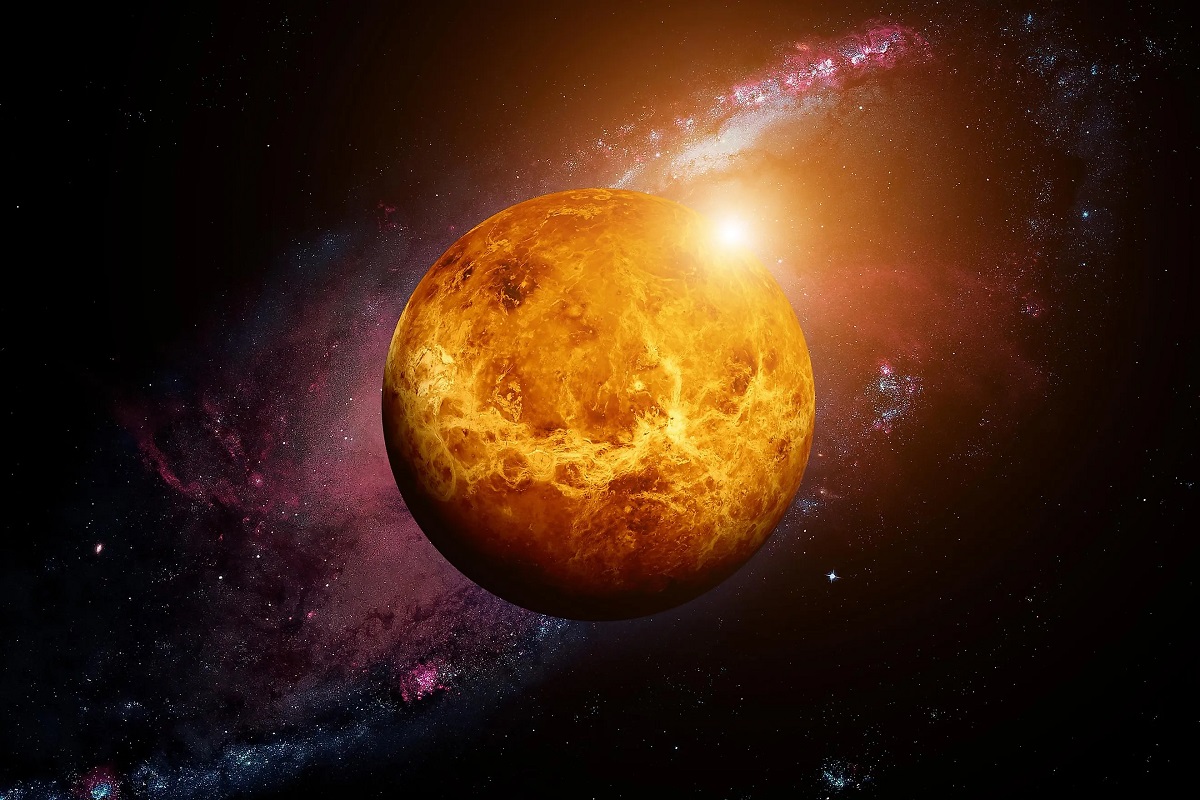Home>Science & Environment>The Hottest Planet In The Solar System


Science & Environment
The Hottest Planet In The Solar System
Published: February 19, 2024
Discover the hottest planet in our solar system and its fascinating features. Explore the science and environment of this extreme world.
(Many of the links in this article redirect to a specific reviewed product. Your purchase of these products through affiliate links helps to generate commission for Temperatures.com, at no extra cost. Learn more)
Table of Contents
Introduction
The solar system is a wondrous expanse, filled with celestial bodies of varying sizes, compositions, and temperatures. Among these, one planet stands out as the hottest: Venus. With its scorching surface temperatures and thick, toxic atmosphere, Venus holds the title of the hottest planet in our solar system. Understanding the unique characteristics of Venus can provide valuable insights into planetary dynamics and the potential for extreme conditions to exist beyond our own cosmic neighborhood.
Venus, often referred to as Earth's "sister planet" due to its similar size and composition, presents a stark contrast in terms of environmental conditions. While Earth teems with life and sustains a diverse range of ecosystems, Venus is a hostile world, shrouded in a dense layer of clouds and subject to surface temperatures that could melt lead. This stark dichotomy invites exploration and study, as it prompts questions about the factors that have shaped these two neighboring planets into such divergent environments.
As we delve into the intricacies of Venus, we will uncover the processes that have contributed to its extreme heat and inhospitable conditions. From its formation to its present state, Venus has undergone a complex evolution, marked by volcanic activity, atmospheric changes, and surface transformations. By unraveling the mysteries of this enigmatic world, we gain a deeper understanding of the forces at play within our solar system and the potential implications for exoplanetary research.
In this article, we will embark on a captivating journey through the fiery domain of Venus, exploring its formation, surface features, atmosphere, and comparative analysis with other planets in the solar system. Additionally, we will contemplate the tantalizing question of whether life could exist in such an extreme environment, shedding light on the profound implications of Venus's status as the hottest planet in our celestial neighborhood. Through this exploration, we aim to unveil the captivating intricacies of Venus and gain a newfound appreciation for the diverse and awe-inspiring nature of the solar system.
Formation of the Hottest Planet
Venus, the hottest planet in our solar system, was formed approximately 4.5 billion years ago through a process that mirrored the birth of other terrestrial planets. During the early stages of the solar system's formation, a swirling disk of gas and dust coalesced to give rise to the rocky bodies that would eventually become the inner planets. Venus emerged from this primordial chaos, gradually taking shape as gravity drew together particles and debris, leading to the formation of a molten protoplanet.
As Venus continued to accrete material from the surrounding debris disk, intense heat generated by radioactive decay and gravitational compression caused the planet to undergo a process of differentiation. This resulted in the separation of its interior into distinct layers, with a dense metallic core forming at the center, surrounded by a mantle and crust. The intense heat from this early phase of planetary formation set the stage for the tumultuous geological activity that would shape Venus into the fiery world we know today.
During its formative years, Venus experienced intense volcanic activity, with vast quantities of magma erupting onto the surface and contributing to the buildup of its crust. This period of volcanic outpouring played a pivotal role in shaping the planet's topography, creating expansive plains and highland regions that endure to this day. The release of volcanic gases, including carbon dioxide and sulfur compounds, also played a crucial role in shaping Venus's atmosphere, setting the stage for the extreme conditions that define the planet's environment.
As Venus continued to evolve, its atmosphere underwent significant changes, leading to the development of a dense, carbon dioxide-rich shroud that traps heat and contributes to the planet's scorching temperatures. The interplay between geological processes and atmospheric dynamics has resulted in the creation of a world that stands in stark contrast to its neighboring planets, earning Venus the distinction of being the hottest planet in the solar system.
The formation of Venus represents a captivating chapter in the cosmic narrative of planetary evolution, offering valuable insights into the forces that have shaped our celestial surroundings. By unraveling the intricate processes that led to the emergence of this searing world, scientists gain a deeper appreciation for the diverse pathways that can unfold during the formation of terrestrial planets. As we continue to explore the mysteries of Venus, we uncover a tapestry of geological and atmospheric phenomena that enrich our understanding of planetary dynamics and the potential for extreme environments to exist within our cosmic neighborhood.
Surface Features of the Hottest Planet
Venus, the hottest planet in our solar system, boasts a striking array of surface features that bear the indelible marks of its tumultuous geological history. The planet's landscape is characterized by vast plains, towering highlands, and enigmatic structures that offer tantalizing glimpses into its complex evolution.
One of the most prominent features of Venus is its expansive plains, known as "planitiae," which cover approximately 65% of the planet's surface. These plains, often referred to as "lava plains," are the result of extensive volcanic activity that has shaped Venus over millions of years. The lava flows that emanated from colossal volcanic eruptions have blanketed large swathes of the planet, creating a relatively smooth terrain punctuated by volcanic domes and channels.
In addition to the lava plains, Venus showcases a diverse array of highland regions, some of which soar to impressive elevations. These highlands, or "terrae," are characterized by rugged, mountainous terrain, with peaks rising as high as 11 kilometers (7 miles) above the surrounding plains. The planet's highest mountain, Maxwell Montes, stands as a testament to the dynamic forces that have sculpted Venus's surface, reaching an elevation of 11 kilometers and spanning an area roughly equivalent to the size of the state of New Mexico.
Furthermore, Venus exhibits a network of striking features known as "coronae," which are thought to result from the upwelling of hot material from the planet's interior. These enigmatic structures, resembling concentric rings or ovals, are believed to be the remnants of ancient volcanic activity and tectonic processes. The presence of coronae on Venus underscores the planet's complex geological history and the enduring influence of internal dynamics on its surface morphology.
Moreover, Venus's surface is adorned with a multitude of impact craters, although their abundance is notably lower than that of other terrestrial planets such as Mercury, the Moon, or Mars. The scarcity of large impact craters on Venus suggests that the planet's surface has been subject to extensive resurfacing, likely due to the pervasive volcanic activity that has reshaped its topography over time.
The diverse and captivating surface features of Venus offer a window into the planet's tumultuous past and the dynamic processes that continue to shape its landscape. By unraveling the mysteries of these geological formations, scientists gain valuable insights into the forces that have sculpted Venus into the fiery world it is today, enriching our understanding of planetary evolution and the remarkable diversity of celestial bodies within our solar system.
Atmosphere of the Hottest Planet
The atmosphere of Venus, the hottest planet in our solar system, is a cauldron of extreme conditions, characterized by dense layers of toxic gases and a runaway greenhouse effect that contributes to its scorching temperatures. Composed primarily of carbon dioxide with traces of nitrogen and other gases, Venus's atmosphere exerts a crushing surface pressure over 90 times that of Earth's atmosphere, creating an environment akin to the pressures found deep beneath the ocean.
One of the defining features of Venus's atmosphere is its thick blanket of clouds, primarily consisting of sulfuric acid droplets. These clouds enshroud the planet, reflecting a significant portion of the sunlight that reaches Venus and contributing to its highly reflective appearance in the sky. The presence of these reflective clouds plays a crucial role in Venus's extreme heat retention, as they trap solar radiation and prevent it from escaping back into space, leading to a runaway greenhouse effect.
The greenhouse effect on Venus is unparalleled in our solar system, resulting in surface temperatures that soar to a staggering 465 degrees Celsius (869 degrees Fahrenheit), making it the hottest planet in our celestial neighborhood. The dense atmosphere acts as a thermal blanket, trapping heat and creating a searing environment that defies conventional expectations for a planet located at a similar distance from the Sun as Earth.
Furthermore, Venus's atmosphere exhibits super-rotation, with winds reaching speeds of up to 360 kilometers per hour (224 miles per hour) at the cloud tops. These ferocious winds, which far exceed the speed of the planet's rotation, contribute to the perpetuation of Venus's extreme atmospheric dynamics, creating a tempestuous environment that stands in stark contrast to the relatively tranquil conditions found on Earth.
The atmospheric composition and dynamics of Venus present a captivating enigma, offering valuable insights into the potential for extreme conditions to exist within our solar system and beyond. By unraveling the complexities of Venus's atmosphere, scientists gain a deeper understanding of the interplay between planetary composition, atmospheric dynamics, and the potential for environmental extremes to shape the evolution of celestial bodies. As we continue to explore the mysteries of Venus's atmosphere, we uncover a tapestry of atmospheric phenomena that enrich our understanding of planetary dynamics and the remarkable diversity of conditions that can exist within our cosmic neighborhood.
Comparison with Other Planets in the Solar System
When comparing Venus, the hottest planet in our solar system, with its planetary counterparts, striking disparities and intriguing parallels come to light. Venus shares several fundamental characteristics with Earth, such as its size, composition, and proximity to the Sun, yet it stands out as an extreme outlier in terms of its environmental conditions. Contrasting Venus with other terrestrial planets, such as Earth and Mars, as well as gas giants like Jupiter and Saturn, unveils the remarkable diversity of planetary environments within our cosmic neighborhood.
In contrast to the scorching temperatures and dense, toxic atmosphere of Venus, Earth boasts a hospitable climate that sustains a rich tapestry of life. The stark divergence between these two neighboring planets underscores the profound influence of atmospheric composition and greenhouse effects on planetary environments. While Earth's atmosphere supports a delicate balance of gases conducive to life, Venus's atmosphere creates a hostile environment characterized by extreme heat and crushing surface pressures.
Mars, often regarded as Earth's "sister planet" alongside Venus, presents a markedly different landscape, with its cold, desolate surface and thin atmosphere. Despite sharing similarities in size and composition with Earth and Venus, Mars stands in stark contrast to its planetary counterparts, offering a glimpse into the diverse range of conditions that can emerge among terrestrial worlds.
When juxtaposed with the gas giants of our solar system, such as Jupiter and Saturn, Venus emerges as a testament to the intricate interplay of planetary composition, atmospheric dynamics, and environmental extremes. The colossal gas giants, with their turbulent atmospheres and massive, swirling storms, present a stark contrast to the searing, greenhouse-dominated environment of Venus, underscoring the vast array of planetary conditions that exist within our celestial sphere.
By examining Venus in the context of its planetary brethren, scientists gain valuable insights into the diverse pathways that can unfold during the evolution of celestial bodies. The comparative analysis of Venus with other planets in our solar system enriches our understanding of planetary dynamics, atmospheric processes, and the potential for extreme environments to shape the evolution of cosmic bodies. As we continue to explore the complexities of our celestial neighborhood, the contrasting characteristics of Venus and its planetary counterparts offer a captivating tapestry of planetary diversity and the remarkable range of conditions that can emerge within our cosmic expanse.
Potential for Life on the Hottest Planet
The scorching, inhospitable environment of Venus presents a formidable barrier to the existence of life as we know it. With surface temperatures capable of melting lead and a dense, toxic atmosphere, the prospects for life to thrive on the hottest planet in our solar system appear exceedingly bleak. However, the exploration of extremophiles, organisms capable of surviving in extreme environments on Earth, has expanded our understanding of the potential for life to endure in seemingly uninhabitable conditions.
While the surface of Venus is a hostile realm, the planet's upper atmosphere, approximately 50 to 65 kilometers above the surface, presents a more temperate and potentially habitable zone. Within this region, the atmospheric pressure and temperature are akin to those found on Earth, offering a potential niche for microbial life to persist. The presence of sulfuric acid clouds in this upper atmosphere has sparked speculation about the possibility of airborne microbial life forms that could harness the energy from sunlight to sustain their existence.
Moreover, recent discoveries of phosphine gas in Venus's atmosphere have ignited scientific intrigue, as phosphine is considered a potential biosignature, a gas that could indicate the presence of microbial life. While the origins of phosphine on Venus remain a subject of ongoing research and debate, the detection of this intriguing molecule has fueled speculation about the potential for life to exist within the planet's enigmatic atmosphere.
The concept of aerial microbial life forms thriving within the upper reaches of Venus's atmosphere has prompted scientists to contemplate the prospect of conducting future missions to investigate this tantalizing possibility. By probing the atmospheric layers of Venus with advanced instruments and technology, researchers aim to unravel the mysteries of this extreme environment and shed light on the potential for life to endure in unexpected corners of our solar system.
While the surface of Venus remains an unforgiving domain, the upper atmosphere presents a compelling frontier for the exploration of potential biospheres beyond Earth. The quest to uncover the presence of life, however unconventional, within the atmospheric realms of Venus represents a captivating endeavor that holds the potential to reshape our understanding of the cosmic boundaries within which life can thrive.
As we continue to push the boundaries of scientific exploration, the tantalizing prospect of life existing within the upper atmosphere of the hottest planet in our solar system serves as a poignant reminder of the resilience and adaptability of life in the face of extreme conditions. The potential for life on Venus, though speculative, offers a thought-provoking avenue for further research and discovery, underscoring the boundless mysteries that await our exploration within the cosmic tapestry of our celestial neighborhood.
Conclusion
The exploration of Venus, the hottest planet in our solar system, unveils a captivating tapestry of extreme conditions, complex geological formations, and tantalizing prospects for the existence of life. From its tumultuous formation to its scorching atmosphere, Venus stands as a testament to the remarkable diversity of planetary environments within our cosmic neighborhood. The planet's surface features, including expansive lava plains, towering highlands, and enigmatic coronae, offer a window into its tumultuous geological history, enriching our understanding of the forces that have shaped this fiery world.
Moreover, Venus's atmosphere, characterized by dense layers of toxic gases and a runaway greenhouse effect, presents a captivating enigma that challenges conventional expectations for a planet located at a similar distance from the Sun as Earth. The interplay of atmospheric composition, greenhouse dynamics, and extreme temperatures on Venus offers valuable insights into the potential for environmental extremes to shape the evolution of celestial bodies, enriching our understanding of planetary dynamics and the remarkable diversity of conditions that can exist within our cosmic neighborhood.
Furthermore, the comparative analysis of Venus with other planets in our solar system underscores the profound influence of atmospheric composition and environmental dynamics on planetary conditions. Contrasting Venus with Earth, Mars, and the gas giants reveals the remarkable diversity of planetary environments within our celestial sphere, offering a compelling tapestry of planetary diversity and the remarkable range of conditions that can emerge within our cosmic expanse.
The tantalizing prospect of life existing within the upper atmosphere of Venus serves as a poignant reminder of the resilience and adaptability of life in the face of extreme conditions. While the surface of Venus remains an unforgiving domain, the potential for microbial life to endure within the planet's atmospheric realms presents a thought-provoking avenue for further research and discovery, underscoring the boundless mysteries that await our exploration within the cosmic tapestry of our celestial neighborhood.
In conclusion, the exploration of Venus, the hottest planet in our solar system, offers a captivating journey through the complexities of planetary evolution, atmospheric dynamics, and the potential for life to endure in unexpected corners of our cosmic neighborhood. By unraveling the mysteries of this enigmatic world, we gain a deeper appreciation for the diverse and awe-inspiring nature of the solar system, igniting a sense of wonder and curiosity about the boundless frontiers that await our exploration within the cosmic expanse.



